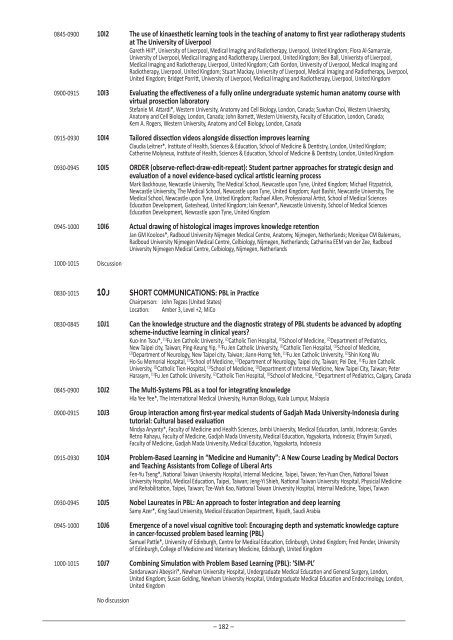AevJ1
AevJ1
AevJ1
Create successful ePaper yourself
Turn your PDF publications into a flip-book with our unique Google optimized e-Paper software.
0845-0900 10I2 The use of kinaesthetic learning tools in the teaching of anatomy to first year radiotherapy studentsat The University of LiverpoolGareth Hill*, University of Liverpool, Medical Imaging and Radiotherapy, Liverpool, United Kingdom; Flora Al-Samarraie,University of Liverpool, Medical Imaging and Radiotherapy, Liverpool, United Kingdom; Bev Ball, Univeristy of Liverpool,Medical Imaging and Radiotherapy, Liverpool, United Kingdom; Cath Gordon, University of Liverpool, Medical Imaging andRadiotherapy, Liverpool, United Kingdom; Stuart Mackay, University of Liverpool, Medical Imaging and Radiotherapy, Liverpool,United Kingdom; Bridget Porritt, University of Liverpool, Medical Imaging and Radiotherapy, Liverpool, United Kingdom0900-0915 10I3 Evaluating the effectiveness of a fully online undergraduate systemic human anatomy course withvirtual prosection laboratoryStefanie M. Attardi*, Western University, Anatomy and Cell Biology, London, Canada; Suwhan Choi, Western University,Anatomy and Cell Biology, London, Canada; John Barnett, Western University, Faculty of Education, London, Canada;Kem A. Rogers, Western University, Anatomy and Cell Biology, London, Canada0915-0930 10I4 Tailored dissection videos alongside dissection improves learningClaudia Leitner*, Institute of Health, Sciences & Education, School of Medicine & Dentistry, London, United Kingdom;Catherine Molyneux, Institute of Health, Sciences & Education, School of Medicine & Dentistry, London, United Kingdom0930-0945 10I5 ORDER (observe-reflect-draw-edit-repeat): Student partner approaches for strategic design andevaluation of a novel evidence-based cyclical artistic learning processMark Backhouse, Newcastle University, The Medical School, Newcastle upon Tyne, United Kingdom; Michael Fitzpatrick,Newcastle University, The Medical School, Newcastle upon Tyne, United Kingdom; Ayat Bashir, Newcastle University, TheMedical School, Newcastle upon Tyne, United Kingdom; Rachael Allen, Professional Artist, School of Medical SciencesEducation Development, Gateshead, United Kingdom; Iain Keenan*, Newcastle University, School of Medical SciencesEducation Development, Newcastle upon Tyne, United Kingdom0945-1000 10I6 Actual drawing of histological images improves knowledge retentionJan GM Kooloos*, Radboud University Nijmegen Medical Centre, Anatomy, Nijmegen, Netherlands; Monique CM Balemans,Radboud University Nijmegen Medical Centre, Celbiology, Nijmegen, Netherlands; Catharina EEM van der Zee, RadboudUniversity Nijmegen Medical Centre, Celbiology, Nijmegen, Netherlands1000-1015 Discussion0830-1015 10J SHORT COMMUNICATIONS: PBL in PracticeChairperson: John Tegzes (United States)Location: Amber 3, Level +2, MiCo0830-0845 10J1 Can the knowledge structure and the diagnostic strategy of PBL students be advanced by adoptingscheme-inductive learning in clinical years?Kuo-Inn Tsou*, (1) Fu Jen Catholic University, (2) Catholic Tien Hospital, (1) School of Medicine, (2) Department of Pediatrics,New Taipei city, Taiwan; Ping-Keung Yip, (1) Fu Jen Catholic University, (2) Catholic Tien Hospital, (1) School of Medicine,(2)Department of Neurology, New Taipei city, Taiwan; Jiann-Horng Yeh, (1) Fu Jen Catholic University, (2) Shin Kong WuHo-Su Memorial Hospital, (1) School of Medicine, (2) Department of Neurology, Taipei city, Taiwan; Pei Dee, (1) Fu Jen CatholicUniversity, (2) Catholic Tien Hospital, (1) School of Medicine, (2) Department of Internal Medicine, New Taipei City, Taiwan; PeterHarasym, (1) Fu Jen Catholic University, (2) Catholic Tien Hospital, (1) School of Medicine, (2) Department of Pediatrics, Calgary, Canada0845-0900 10J2 The Multi-Systems PBL as a tool for integrating knowledgeHla Yee Yee*, The International Medical University, Human Biology, Kuala Lumpur, Malaysia0900-0915 10J3 Group interaction among first-year medical students of Gadjah Mada University-Indonesia duringtutorial: Cultural based evaluationNindya Aryanty*, Faculty of Medicine and Health Sciences, Jambi University, Medical Education, Jambi, Indonesia; GandesRetno Rahayu, Faculty of Medicine, Gadjah Mada University, Medical Education, Yogyakarta, Indonesia; Efrayim Suryadi,Faculty of Medicine, Gadjah Mada University, Medical Education, Yogyakarta, Indonesia0915-0930 10J4 Problem-Based Learning in “Medicine and Humanity”: A New Course Leading by Medical Doctorsand Teaching Assistants from College of Liberal ArtsFen-Yu Tseng*, National Taiwan University Hospital, Internal Medicine, Taipei, Taiwan; Yen-Yuan Chen, National TaiwanUniversity Hospital, Medical Education, Taipei, Taiwan; Jeng-Yi Shieh, National Taiwan University Hospital, Physicial Medicineand Rehabilitation, Taipei, Taiwan; Tze-Wah Kao, National Taiwan University Hospital, Internal Medicine, Taipei, Taiwan0930-0945 10J5 Nobel Laureates in PBL: An approach to foster integration and deep learningSamy Azer*, King Saud University, Medical Education Department, Riyadh, Saudi Arabia0945-1000 10J6 Emergence of a novel visual cognitive tool: Encouraging depth and systematic knowledge capturein cancer-focussed problem based learning (PBL)Samuel Pattle*, University of Edinburgh, Centre for Medical Education, Edinburgh, United Kingdom; Fred Pender, Universityof Edinburgh, College of Medicine and Veterinary Medicine, Edinburgh, United Kingdom1000-1015 10J7 Combining Simulation with Problem Based Learning (PBL): ‘SIM-PL’Sandaruwani Abeysiri*, Newham University Hospital, Undergraduate Medical Education and General Surgery, London,United Kingdom; Susan Gelding, Newham University Hospital, Undergraduate Medical Education and Endocrinology, London,United KingdomNo discussion– 182 –



